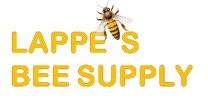We're Buzzing With Knowledge!!
FAQs and Essential Information on Honey Bees and Beekeeping
Welcome to the Lappe's Bee Supply FAQs page, where we address frequently asked questions regarding our products and services. As a reputable beekeeping supply company, we are here to assist you every step of the way.
Beginner Beginning Beekeeping FAQ

 Queen Honey Bees FAQ
Queen Honey Bees FAQ 
Question: My queen was released but she’s nowhere to be found. What happened?
Answer: The most common reason that queens go missing is not knowing that you have queen cells in the hive when you introduce the queen. The bees will get the queen out of the queen cage and immediately be ready to swarm, because of the queen cells.
Another reason can be the hive is too far in decline, there’s no nurse bees in the hive and the old worker bees don’t like new queens, and they look at her like she’s not supposed to be in there, and she is a threat. They will release her from the queen cage, ball and kill her, and haul her out of the hive.
The third main reason can be that you have disturbed the hive to see if the queen had been released too soon or too often, the hive becomes agitated and sees the just released queen as a threat and take their aggressions out on her. They will ball and kill her and haul her out of the hive. This can happen at any time of the year but happens more often during the late summer months into the fall months.
Question: Does the acceptance of a queen depend on if she’s mated or not?
Answer: No, not at all, this is just an old beekeeping myth, there is no truth to it. Bees will accept any type of queen, no matter if she’s mated or if she’s a virgin queen. The factors that make the difference are if they are ready to accept a queen or if she is introduced properly. Mated or not mated queens have nothing to do with the bees not accepting a new queen whatsoever.
Question: All of the conditions were right for introducing my new queen into a split, so why didn’t my hive accept her?
Answer: Commercial beekeepers do thousands of splits each year, and there’s always a percentage of new splits that will not accept a new queen, no matter what. Usually what has to be done after 2 or 3 new queens have been attempted to be introduced unsuccessfully, is to put the split back together with the parent colony (original bee hive they came from) and leave them be.
Question: Is it the responsibility of the queen supplier to replace my queen if the requeening of my hive or my split was unsuccessful?
Answer: No, the supplier is not at fault at all. Bees will accept any type of queen if the conditions are right with the beehive, or if the queen is introduced correctly. Any time that the queens are not accepted, it has to do solely with the bees in the hive, not the queen herself, and the responsibility for that falls with the person that owns the beehive. The queen supplier’s responsibility for that queen ends when they get you a mated queen alive, anything that you choose to do with the queen after that is totally up to you as the beekeeper.
Question: Is It True That Queen Bees That Make A Piping Noise Are Not Mated?
Answer: Not at all! All queens make the piping noises and the tooting noises like a train whistle, that is their way of communicating to their attendants that they need something. Also, queen honey bees will pipe when they are around other queens to signal a threat. Newly mated queens will make piping sounds that sound different, but it does not mean that she is not mated, she is just very young so it sounds different.

 Beginner Beginning Beekeeping FAQ
Beginner Beginning Beekeeping FAQ 
Question: How Do You Begin Beekeeping? How Many Honey Bee Hives Should I Start With?
Answer: Before you dive into beekeeping, it's essential to understand the biology and behavior of bees. Honeybees live in complex, highly organized societies, with each bee playing a specific role. A typical hive consists of the queen bee (the sole reproductive individual), worker bees (sterile females that perform various tasks), and drones (males whose primary role is to mate with the queen). Beekeeping and honey bees are more complex than most people think, and knowledge before starting will benefit you greatly in the long run.
To get a solid understanding of bee biology and the principles of beekeeping, consider enrolling in a beekeeping class. Reading books on beekeeping, watching educational videos, and joining online beekeeping communities can also provide valuable insights. Finding a local beekeeping club can also be hugely beneficial for novice beekeepers. These clubs offer a platform to learn from experienced beekeepers, participate in workshops, and stay updated on the latest beekeeping practices. Moreover, they provide an opportunity to connect with a mentor who can guide you through your beekeeping journey.
A bee starter kit is an excellent investment for beginner beekeepers. These kits typically include a hive body, frames, a feeder, a smoker, a hive tool, and protective clothing. It's worth noting that the quality of equipment can significantly impact your beekeeping experience, so it's advisable to invest in high-quality, durable gear.
Beekeeping is a lifelong learning process. As you gain more experience, you'll likely encounter new challenges and situations. Continuing to educate yourself, staying up-to-date with the latest research, and engaging with the beekeeping community are essential for becoming a successful beekeeper.
SHOP BEGINNING BEEKEEPING SUPPLIES!
Start with however many bee hives you would like to, or however many your budget can afford. We always advise new beekeepers to start out with at least 2 or 3 bee hives - that way you can compare them with each other for strength and activity; you can swap frames around with some of them to help strengthen a hive up, and if you lose 1 hive during the winter, you'll still have the other hives instead of having to start over again the next spring.
Question: How Many Bee Hives Should I Start Out With?
Answer: If your budget will allow it, you should start out with at least 2 hives. That way, you can use how well the hives are doing to judge if one is having an issue, and if it is, you can use the other to help it survive. If one of the hives has less brood than the other, you can switch a couple of frames of brood / bees from the stronger hive and place them into the weaker hive - just MAKE SURE you don’t have a frame with the queen on it!

 Beekeeping FAQ
Beekeeping FAQ 
Question: Where Should I Place My Bee Hives? How Much Distance Apart Do Bee Hives Need?
Answer: When you're figuring out where to place your bee hives, there are a few important things to keep in mind to ensure your bees are happy and healthy. You can actually put the hives right next to each other, as long as you have enough space to work on them easily. In commercial setups, it's common to stack four hives on a pallet, with about ten pallets positioned in each location.
A good spot for a bee yard is often just a little unused area of a field, providing a calm and peaceful environment for the bees. Just make sure to keep the hives at least 10 feet away from places where people often gather. This distance helps avoid any issues that might come up if the hives are too close to the public. By following these tips, you’ll create a safe and productive space for your bees to thrive.

 Honey Bees FAQ
Honey Bees FAQ 

 Honey FAQ
Honey FAQ 


